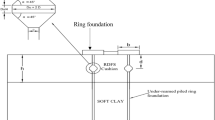Abstract
Ultimate bearing capacity of jointed rock mass specimens, studied by distinct element software UDEC which allows explicit modelling of blocks of rock, is presented in this paper. Since the other numerical methods like FEM considers the rock mass as continuum, their applicability to anisotropic blocky rock masses remains doubtful. A series of numerical tests has been conducted, by developing a programme using fish functions, on rock mass having two orthogonal joint set with the joint orientation from 0° to 90°. Simple models have been assigned to rock material and joints. An experimental study was conducted by Bindlish (Bearing capacity of strip footings on jointed rocks, 2007) wherein a rigid footing placed on the top surface of the jointed rock mass was loaded up to the failure. The effect of the joint orientation and interlocking of rock mass on the ultimate bearing capacity of the rock mass was studied. The numerical findings by distinct element software UDEC on the ultimate bearing capacity of the jointed rock mass have been found to be close to the experimental results obtained by the author.

















Similar content being viewed by others
Abbreviations
- c i and ϕ i :
-
Shear strength parameters of intact rock
- q ult :
-
Ultimate bearing capacity
- β :
-
Orientation of joint plane w.r.t. loading direction
- γ :
-
Unit weight of the rock mass
- γ d :
-
Dry density
- σ ci :
-
Uniaxial compressive strength of the intact rock
- θ :
-
Dip of continuous joint plane w.r.t. horizontal
References
Bindlish A (2007) Bearing capacity of strip footings on jointed rocks, Published Ph.D. Thesis, Civil Engineering Department, IIT Roorkee, Roorkee, India
Bindlish A, Singh M, Samadhiya NK (2012) An experimental study on ultimate bearing capacity of a foundation in anisotropic rock masses. J Rock Mech Tunnel Technol 18(2):79–96
Cundall PA, Strack ODL (1979) A discrete numerical model for granular assemblies. Geotechnique 29(1):47–65
Cundall PA and Hart RD (1992) Numerical modeling of discontinua, Eng Comp, 9(2), 101–113; in Comprehensive rock engineering, Vol. 2, p 231–243
Itasca (2000) UDEC user’s guide (version 3.1). Minneapolis: Itasca Consulting Group Inc.
Singh M, Rao KS (2005) Bearing capacity of shallow foundations in anisotropic non-hoek-brown rock masses. J Geotechnical Geoenvironmental Engineering 131(8):1014–1023
Author information
Authors and Affiliations
Corresponding author
Rights and permissions
About this article
Cite this article
Bindlish, A., Singh, M. & Samadhiya, N.K. Modeling of Ultimate Bearing Capacity of Shallow Foundations resting on Jointed Rock Mass. Indian Geotech J 43, 251–266 (2013). https://doi.org/10.1007/s40098-013-0065-3
Received:
Accepted:
Published:
Issue Date:
DOI: https://doi.org/10.1007/s40098-013-0065-3




